Impact of Employee Relations on Stakeholder Behavior at M&S
VerifiedAdded on 2023/06/04
|11
|3497
|199
Report
AI Summary
This report explores the critical role of employee relations in shaping the behavior of various stakeholders within an organization, using Marks & Spencer (M&S) as a case study. It highlights the importance of positive employee relations, effective communication, and adherence to employment laws. The report analyzes the duties, rights, and obligations of both employers and employees, suggesting ways to enhance employee relations through improved communication, flexible structures, career development, and appreciation. Furthermore, it examines the influence of stakeholders such as employees, customers, government, suppliers, and shareholders on employee relations, discussing the positive and negative implications of stakeholder engagement. The analysis emphasizes how a healthy employee-employer relationship, coupled with effective stakeholder management, contributes to organizational success and a positive working environment. Desklib offers additional resources, including past papers and solved assignments, for students seeking further information on this topic.
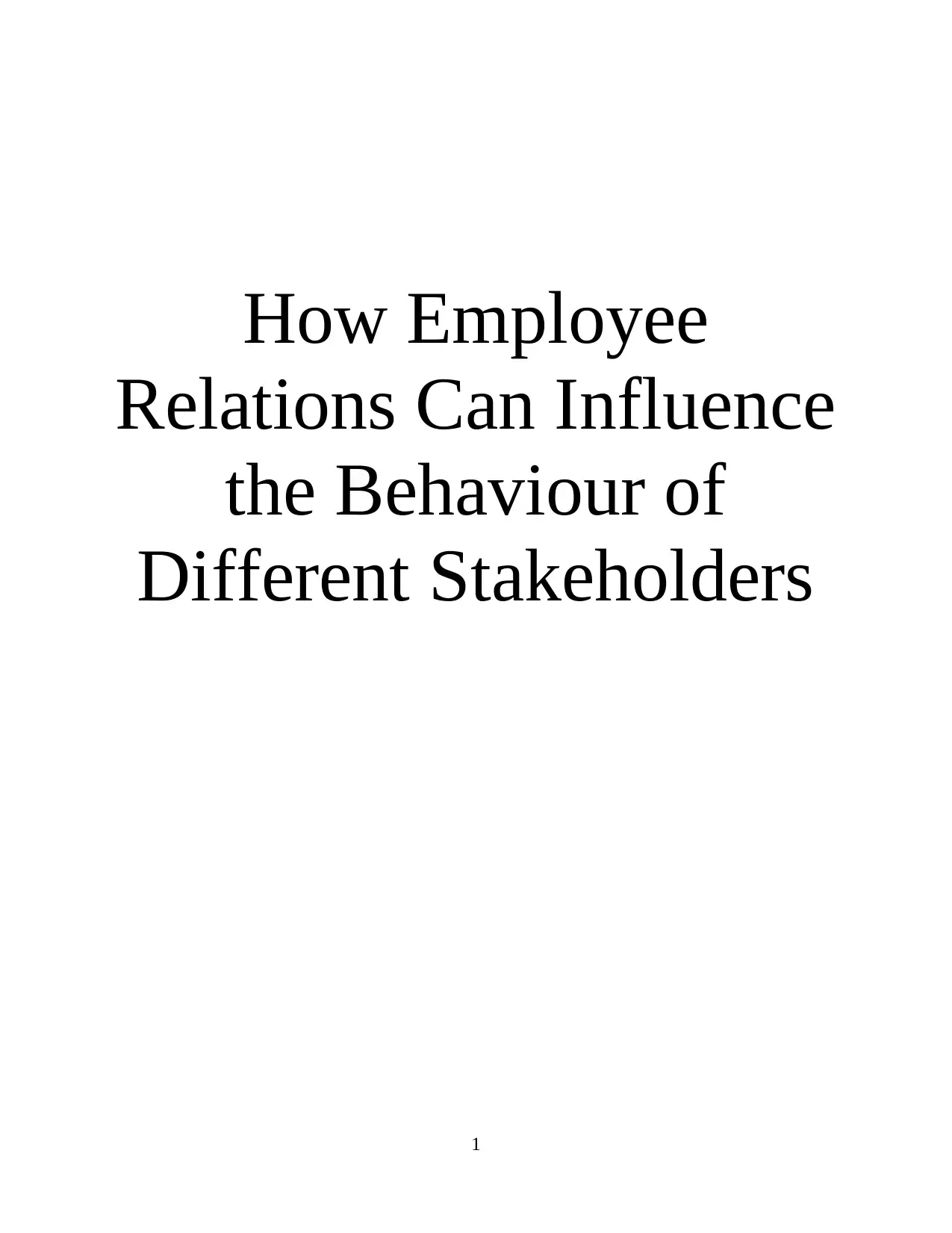
How Employee
Relations Can Influence
the Behaviour of
Different Stakeholders
1
Relations Can Influence
the Behaviour of
Different Stakeholders
1
Paraphrase This Document
Need a fresh take? Get an instant paraphrase of this document with our AI Paraphraser
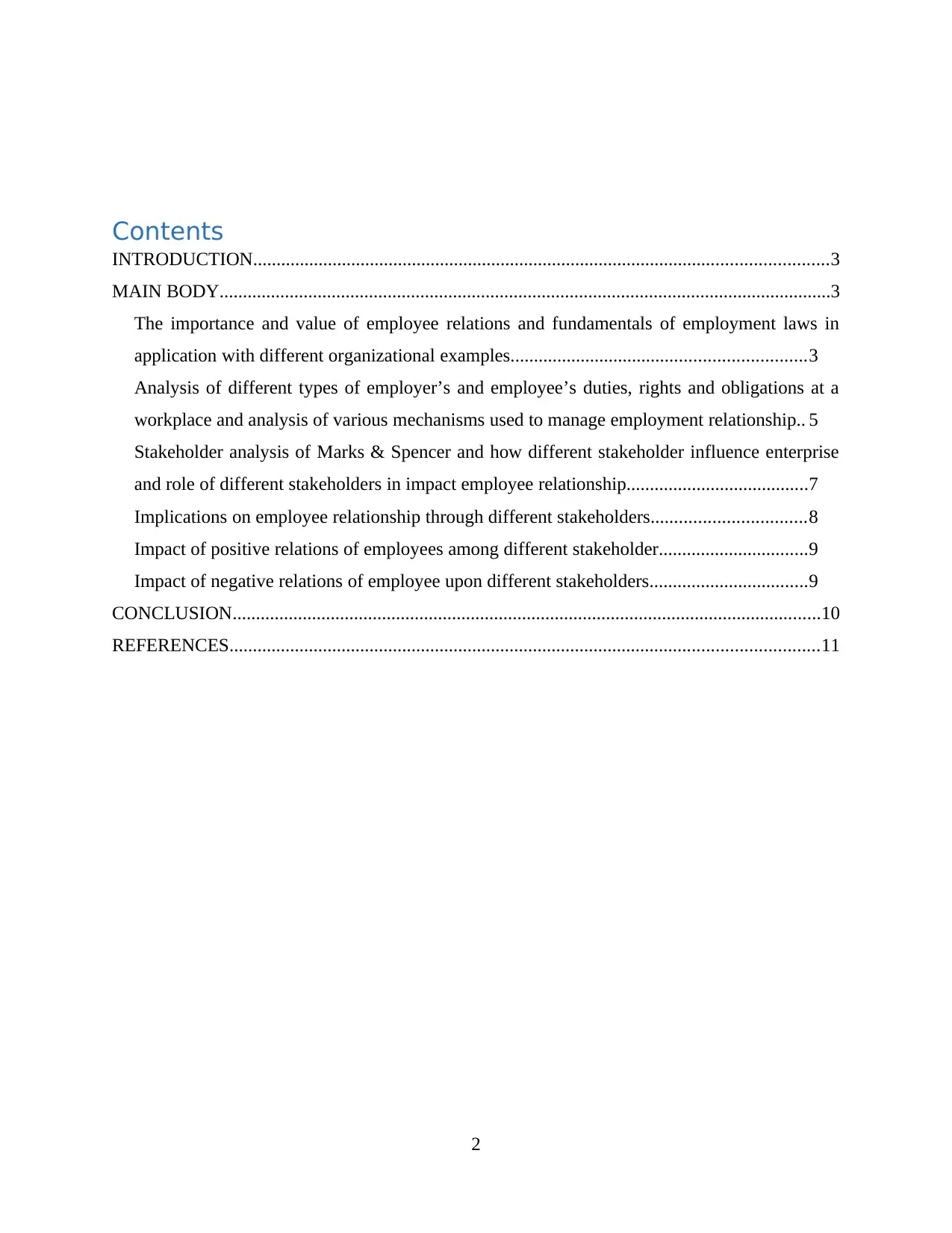
Contents
INTRODUCTION...........................................................................................................................3
MAIN BODY...................................................................................................................................3
The importance and value of employee relations and fundamentals of employment laws in
application with different organizational examples...............................................................3
Analysis of different types of employer’s and employee’s duties, rights and obligations at a
workplace and analysis of various mechanisms used to manage employment relationship.. 5
Stakeholder analysis of Marks & Spencer and how different stakeholder influence enterprise
and role of different stakeholders in impact employee relationship.......................................7
Implications on employee relationship through different stakeholders.................................8
Impact of positive relations of employees among different stakeholder................................9
Impact of negative relations of employee upon different stakeholders..................................9
CONCLUSION..............................................................................................................................10
REFERENCES..............................................................................................................................11
2
INTRODUCTION...........................................................................................................................3
MAIN BODY...................................................................................................................................3
The importance and value of employee relations and fundamentals of employment laws in
application with different organizational examples...............................................................3
Analysis of different types of employer’s and employee’s duties, rights and obligations at a
workplace and analysis of various mechanisms used to manage employment relationship.. 5
Stakeholder analysis of Marks & Spencer and how different stakeholder influence enterprise
and role of different stakeholders in impact employee relationship.......................................7
Implications on employee relationship through different stakeholders.................................8
Impact of positive relations of employees among different stakeholder................................9
Impact of negative relations of employee upon different stakeholders..................................9
CONCLUSION..............................................................................................................................10
REFERENCES..............................................................................................................................11
2
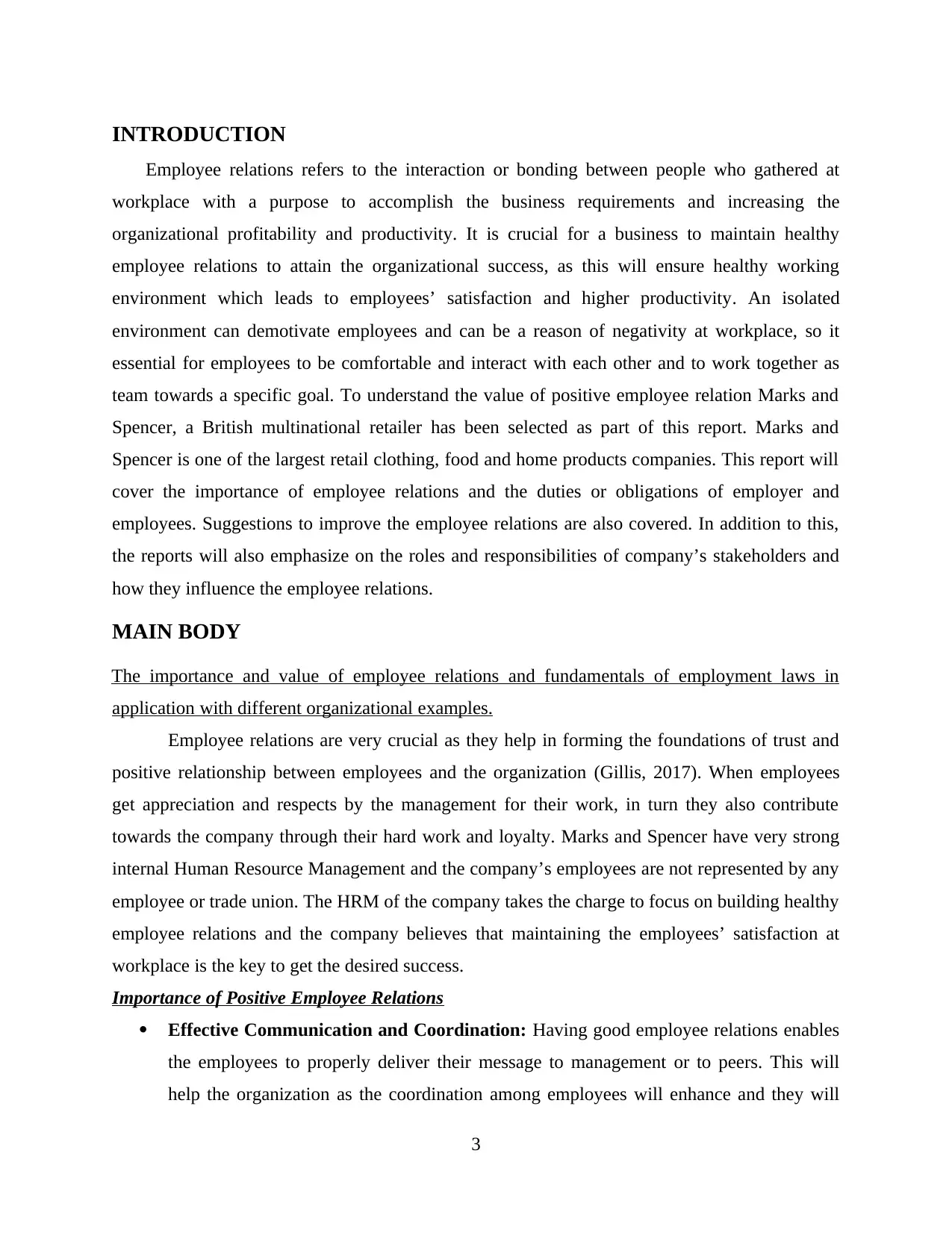
INTRODUCTION
Employee relations refers to the interaction or bonding between people who gathered at
workplace with a purpose to accomplish the business requirements and increasing the
organizational profitability and productivity. It is crucial for a business to maintain healthy
employee relations to attain the organizational success, as this will ensure healthy working
environment which leads to employees’ satisfaction and higher productivity. An isolated
environment can demotivate employees and can be a reason of negativity at workplace, so it
essential for employees to be comfortable and interact with each other and to work together as
team towards a specific goal. To understand the value of positive employee relation Marks and
Spencer, a British multinational retailer has been selected as part of this report. Marks and
Spencer is one of the largest retail clothing, food and home products companies. This report will
cover the importance of employee relations and the duties or obligations of employer and
employees. Suggestions to improve the employee relations are also covered. In addition to this,
the reports will also emphasize on the roles and responsibilities of company’s stakeholders and
how they influence the employee relations.
MAIN BODY
The importance and value of employee relations and fundamentals of employment laws in
application with different organizational examples.
Employee relations are very crucial as they help in forming the foundations of trust and
positive relationship between employees and the organization (Gillis, 2017). When employees
get appreciation and respects by the management for their work, in turn they also contribute
towards the company through their hard work and loyalty. Marks and Spencer have very strong
internal Human Resource Management and the company’s employees are not represented by any
employee or trade union. The HRM of the company takes the charge to focus on building healthy
employee relations and the company believes that maintaining the employees’ satisfaction at
workplace is the key to get the desired success.
Importance of Positive Employee Relations
Effective Communication and Coordination: Having good employee relations enables
the employees to properly deliver their message to management or to peers. This will
help the organization as the coordination among employees will enhance and they will
3
Employee relations refers to the interaction or bonding between people who gathered at
workplace with a purpose to accomplish the business requirements and increasing the
organizational profitability and productivity. It is crucial for a business to maintain healthy
employee relations to attain the organizational success, as this will ensure healthy working
environment which leads to employees’ satisfaction and higher productivity. An isolated
environment can demotivate employees and can be a reason of negativity at workplace, so it
essential for employees to be comfortable and interact with each other and to work together as
team towards a specific goal. To understand the value of positive employee relation Marks and
Spencer, a British multinational retailer has been selected as part of this report. Marks and
Spencer is one of the largest retail clothing, food and home products companies. This report will
cover the importance of employee relations and the duties or obligations of employer and
employees. Suggestions to improve the employee relations are also covered. In addition to this,
the reports will also emphasize on the roles and responsibilities of company’s stakeholders and
how they influence the employee relations.
MAIN BODY
The importance and value of employee relations and fundamentals of employment laws in
application with different organizational examples.
Employee relations are very crucial as they help in forming the foundations of trust and
positive relationship between employees and the organization (Gillis, 2017). When employees
get appreciation and respects by the management for their work, in turn they also contribute
towards the company through their hard work and loyalty. Marks and Spencer have very strong
internal Human Resource Management and the company’s employees are not represented by any
employee or trade union. The HRM of the company takes the charge to focus on building healthy
employee relations and the company believes that maintaining the employees’ satisfaction at
workplace is the key to get the desired success.
Importance of Positive Employee Relations
Effective Communication and Coordination: Having good employee relations enables
the employees to properly deliver their message to management or to peers. This will
help the organization as the coordination among employees will enhance and they will
3
⊘ This is a preview!⊘
Do you want full access?
Subscribe today to unlock all pages.

Trusted by 1+ million students worldwide
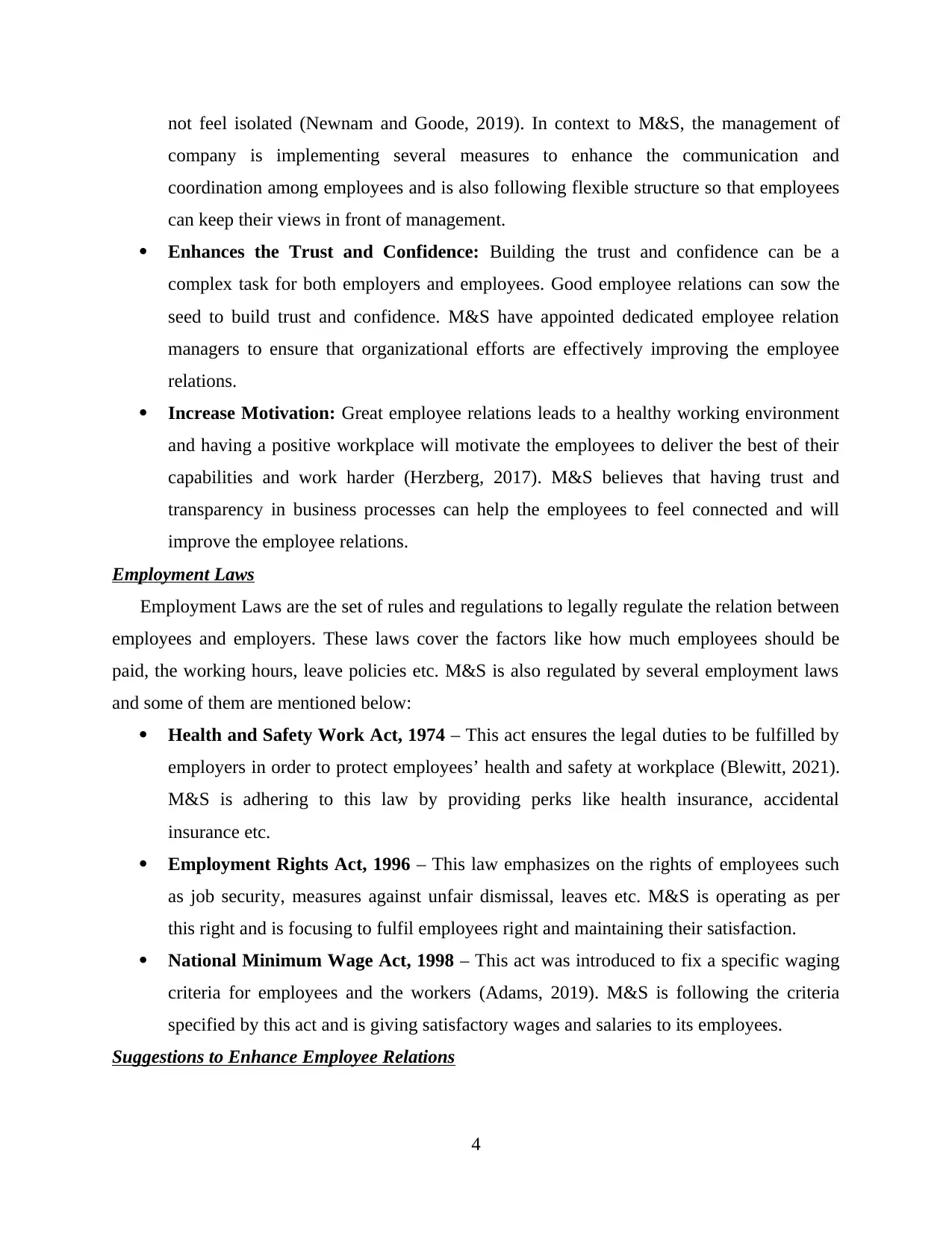
not feel isolated (Newnam and Goode, 2019). In context to M&S, the management of
company is implementing several measures to enhance the communication and
coordination among employees and is also following flexible structure so that employees
can keep their views in front of management.
Enhances the Trust and Confidence: Building the trust and confidence can be a
complex task for both employers and employees. Good employee relations can sow the
seed to build trust and confidence. M&S have appointed dedicated employee relation
managers to ensure that organizational efforts are effectively improving the employee
relations.
Increase Motivation: Great employee relations leads to a healthy working environment
and having a positive workplace will motivate the employees to deliver the best of their
capabilities and work harder (Herzberg, 2017). M&S believes that having trust and
transparency in business processes can help the employees to feel connected and will
improve the employee relations.
Employment Laws
Employment Laws are the set of rules and regulations to legally regulate the relation between
employees and employers. These laws cover the factors like how much employees should be
paid, the working hours, leave policies etc. M&S is also regulated by several employment laws
and some of them are mentioned below:
Health and Safety Work Act, 1974 – This act ensures the legal duties to be fulfilled by
employers in order to protect employees’ health and safety at workplace (Blewitt, 2021).
M&S is adhering to this law by providing perks like health insurance, accidental
insurance etc.
Employment Rights Act, 1996 – This law emphasizes on the rights of employees such
as job security, measures against unfair dismissal, leaves etc. M&S is operating as per
this right and is focusing to fulfil employees right and maintaining their satisfaction.
National Minimum Wage Act, 1998 – This act was introduced to fix a specific waging
criteria for employees and the workers (Adams, 2019). M&S is following the criteria
specified by this act and is giving satisfactory wages and salaries to its employees.
Suggestions to Enhance Employee Relations
4
company is implementing several measures to enhance the communication and
coordination among employees and is also following flexible structure so that employees
can keep their views in front of management.
Enhances the Trust and Confidence: Building the trust and confidence can be a
complex task for both employers and employees. Good employee relations can sow the
seed to build trust and confidence. M&S have appointed dedicated employee relation
managers to ensure that organizational efforts are effectively improving the employee
relations.
Increase Motivation: Great employee relations leads to a healthy working environment
and having a positive workplace will motivate the employees to deliver the best of their
capabilities and work harder (Herzberg, 2017). M&S believes that having trust and
transparency in business processes can help the employees to feel connected and will
improve the employee relations.
Employment Laws
Employment Laws are the set of rules and regulations to legally regulate the relation between
employees and employers. These laws cover the factors like how much employees should be
paid, the working hours, leave policies etc. M&S is also regulated by several employment laws
and some of them are mentioned below:
Health and Safety Work Act, 1974 – This act ensures the legal duties to be fulfilled by
employers in order to protect employees’ health and safety at workplace (Blewitt, 2021).
M&S is adhering to this law by providing perks like health insurance, accidental
insurance etc.
Employment Rights Act, 1996 – This law emphasizes on the rights of employees such
as job security, measures against unfair dismissal, leaves etc. M&S is operating as per
this right and is focusing to fulfil employees right and maintaining their satisfaction.
National Minimum Wage Act, 1998 – This act was introduced to fix a specific waging
criteria for employees and the workers (Adams, 2019). M&S is following the criteria
specified by this act and is giving satisfactory wages and salaries to its employees.
Suggestions to Enhance Employee Relations
4
Paraphrase This Document
Need a fresh take? Get an instant paraphrase of this document with our AI Paraphraser
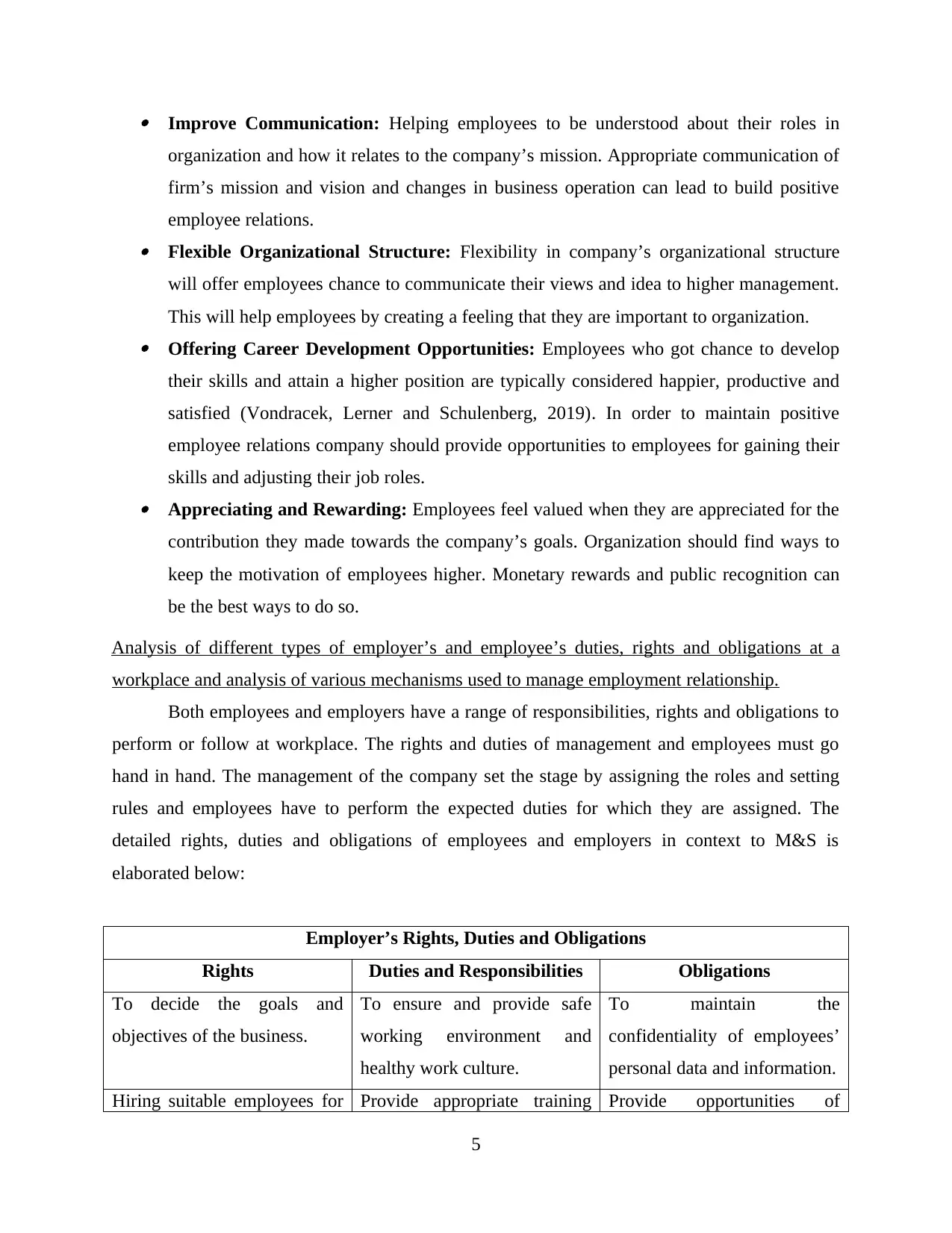
Improve Communication: Helping employees to be understood about their roles in
organization and how it relates to the company’s mission. Appropriate communication of
firm’s mission and vision and changes in business operation can lead to build positive
employee relations. Flexible Organizational Structure: Flexibility in company’s organizational structure
will offer employees chance to communicate their views and idea to higher management.
This will help employees by creating a feeling that they are important to organization. Offering Career Development Opportunities: Employees who got chance to develop
their skills and attain a higher position are typically considered happier, productive and
satisfied (Vondracek, Lerner and Schulenberg, 2019). In order to maintain positive
employee relations company should provide opportunities to employees for gaining their
skills and adjusting their job roles. Appreciating and Rewarding: Employees feel valued when they are appreciated for the
contribution they made towards the company’s goals. Organization should find ways to
keep the motivation of employees higher. Monetary rewards and public recognition can
be the best ways to do so.
Analysis of different types of employer’s and employee’s duties, rights and obligations at a
workplace and analysis of various mechanisms used to manage employment relationship.
Both employees and employers have a range of responsibilities, rights and obligations to
perform or follow at workplace. The rights and duties of management and employees must go
hand in hand. The management of the company set the stage by assigning the roles and setting
rules and employees have to perform the expected duties for which they are assigned. The
detailed rights, duties and obligations of employees and employers in context to M&S is
elaborated below:
Employer’s Rights, Duties and Obligations
Rights Duties and Responsibilities Obligations
To decide the goals and
objectives of the business.
To ensure and provide safe
working environment and
healthy work culture.
To maintain the
confidentiality of employees’
personal data and information.
Hiring suitable employees for Provide appropriate training Provide opportunities of
5
organization and how it relates to the company’s mission. Appropriate communication of
firm’s mission and vision and changes in business operation can lead to build positive
employee relations. Flexible Organizational Structure: Flexibility in company’s organizational structure
will offer employees chance to communicate their views and idea to higher management.
This will help employees by creating a feeling that they are important to organization. Offering Career Development Opportunities: Employees who got chance to develop
their skills and attain a higher position are typically considered happier, productive and
satisfied (Vondracek, Lerner and Schulenberg, 2019). In order to maintain positive
employee relations company should provide opportunities to employees for gaining their
skills and adjusting their job roles. Appreciating and Rewarding: Employees feel valued when they are appreciated for the
contribution they made towards the company’s goals. Organization should find ways to
keep the motivation of employees higher. Monetary rewards and public recognition can
be the best ways to do so.
Analysis of different types of employer’s and employee’s duties, rights and obligations at a
workplace and analysis of various mechanisms used to manage employment relationship.
Both employees and employers have a range of responsibilities, rights and obligations to
perform or follow at workplace. The rights and duties of management and employees must go
hand in hand. The management of the company set the stage by assigning the roles and setting
rules and employees have to perform the expected duties for which they are assigned. The
detailed rights, duties and obligations of employees and employers in context to M&S is
elaborated below:
Employer’s Rights, Duties and Obligations
Rights Duties and Responsibilities Obligations
To decide the goals and
objectives of the business.
To ensure and provide safe
working environment and
healthy work culture.
To maintain the
confidentiality of employees’
personal data and information.
Hiring suitable employees for Provide appropriate training Provide opportunities of
5
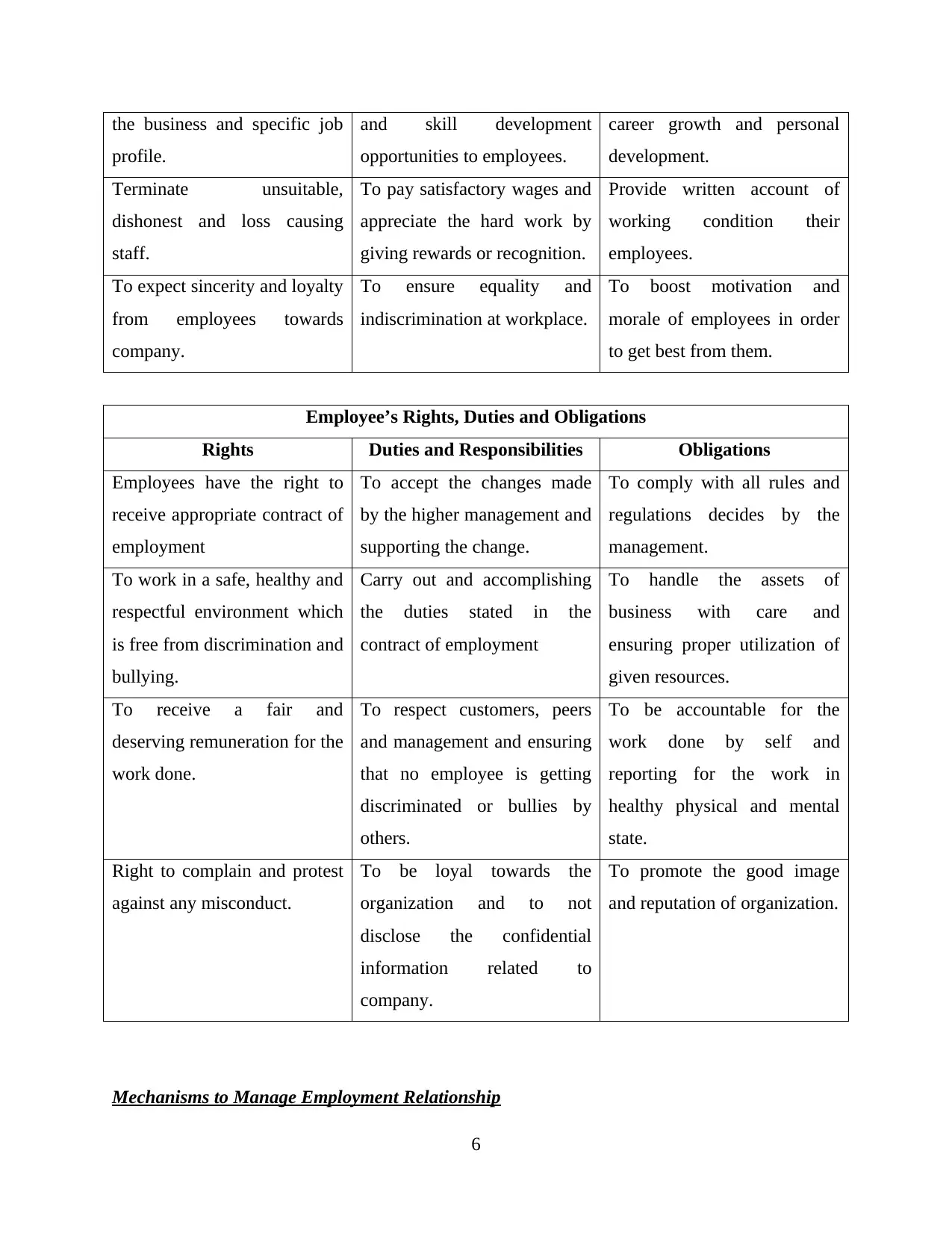
the business and specific job
profile.
and skill development
opportunities to employees.
career growth and personal
development.
Terminate unsuitable,
dishonest and loss causing
staff.
To pay satisfactory wages and
appreciate the hard work by
giving rewards or recognition.
Provide written account of
working condition their
employees.
To expect sincerity and loyalty
from employees towards
company.
To ensure equality and
indiscrimination at workplace.
To boost motivation and
morale of employees in order
to get best from them.
Employee’s Rights, Duties and Obligations
Rights Duties and Responsibilities Obligations
Employees have the right to
receive appropriate contract of
employment
To accept the changes made
by the higher management and
supporting the change.
To comply with all rules and
regulations decides by the
management.
To work in a safe, healthy and
respectful environment which
is free from discrimination and
bullying.
Carry out and accomplishing
the duties stated in the
contract of employment
To handle the assets of
business with care and
ensuring proper utilization of
given resources.
To receive a fair and
deserving remuneration for the
work done.
To respect customers, peers
and management and ensuring
that no employee is getting
discriminated or bullies by
others.
To be accountable for the
work done by self and
reporting for the work in
healthy physical and mental
state.
Right to complain and protest
against any misconduct.
To be loyal towards the
organization and to not
disclose the confidential
information related to
company.
To promote the good image
and reputation of organization.
Mechanisms to Manage Employment Relationship
6
profile.
and skill development
opportunities to employees.
career growth and personal
development.
Terminate unsuitable,
dishonest and loss causing
staff.
To pay satisfactory wages and
appreciate the hard work by
giving rewards or recognition.
Provide written account of
working condition their
employees.
To expect sincerity and loyalty
from employees towards
company.
To ensure equality and
indiscrimination at workplace.
To boost motivation and
morale of employees in order
to get best from them.
Employee’s Rights, Duties and Obligations
Rights Duties and Responsibilities Obligations
Employees have the right to
receive appropriate contract of
employment
To accept the changes made
by the higher management and
supporting the change.
To comply with all rules and
regulations decides by the
management.
To work in a safe, healthy and
respectful environment which
is free from discrimination and
bullying.
Carry out and accomplishing
the duties stated in the
contract of employment
To handle the assets of
business with care and
ensuring proper utilization of
given resources.
To receive a fair and
deserving remuneration for the
work done.
To respect customers, peers
and management and ensuring
that no employee is getting
discriminated or bullies by
others.
To be accountable for the
work done by self and
reporting for the work in
healthy physical and mental
state.
Right to complain and protest
against any misconduct.
To be loyal towards the
organization and to not
disclose the confidential
information related to
company.
To promote the good image
and reputation of organization.
Mechanisms to Manage Employment Relationship
6
⊘ This is a preview!⊘
Do you want full access?
Subscribe today to unlock all pages.

Trusted by 1+ million students worldwide
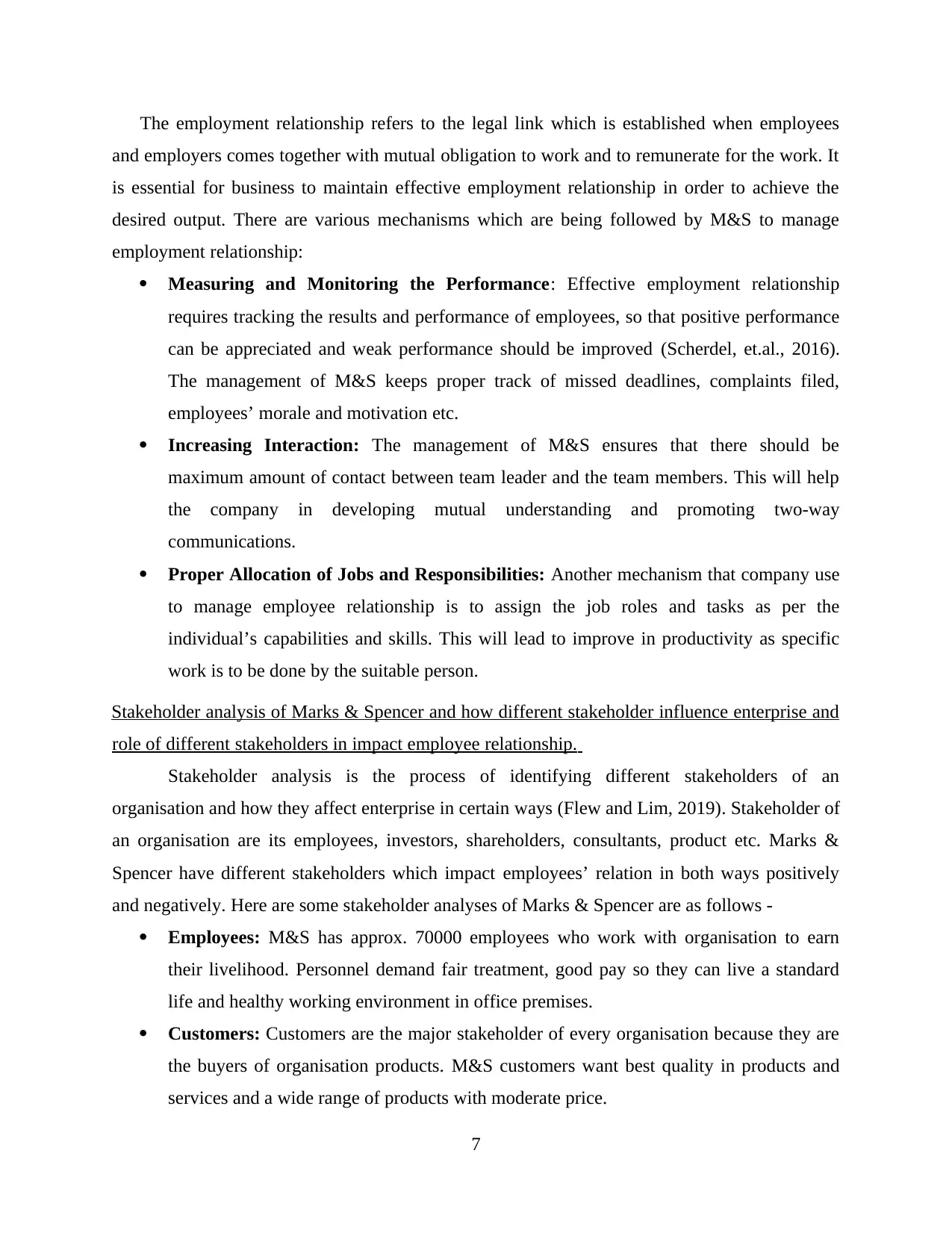
The employment relationship refers to the legal link which is established when employees
and employers comes together with mutual obligation to work and to remunerate for the work. It
is essential for business to maintain effective employment relationship in order to achieve the
desired output. There are various mechanisms which are being followed by M&S to manage
employment relationship:
Measuring and Monitoring the Performance: Effective employment relationship
requires tracking the results and performance of employees, so that positive performance
can be appreciated and weak performance should be improved (Scherdel, et.al., 2016).
The management of M&S keeps proper track of missed deadlines, complaints filed,
employees’ morale and motivation etc.
Increasing Interaction: The management of M&S ensures that there should be
maximum amount of contact between team leader and the team members. This will help
the company in developing mutual understanding and promoting two-way
communications.
Proper Allocation of Jobs and Responsibilities: Another mechanism that company use
to manage employee relationship is to assign the job roles and tasks as per the
individual’s capabilities and skills. This will lead to improve in productivity as specific
work is to be done by the suitable person.
Stakeholder analysis of Marks & Spencer and how different stakeholder influence enterprise and
role of different stakeholders in impact employee relationship.
Stakeholder analysis is the process of identifying different stakeholders of an
organisation and how they affect enterprise in certain ways (Flew and Lim, 2019). Stakeholder of
an organisation are its employees, investors, shareholders, consultants, product etc. Marks &
Spencer have different stakeholders which impact employees’ relation in both ways positively
and negatively. Here are some stakeholder analyses of Marks & Spencer are as follows -
Employees: M&S has approx. 70000 employees who work with organisation to earn
their livelihood. Personnel demand fair treatment, good pay so they can live a standard
life and healthy working environment in office premises.
Customers: Customers are the major stakeholder of every organisation because they are
the buyers of organisation products. M&S customers want best quality in products and
services and a wide range of products with moderate price.
7
and employers comes together with mutual obligation to work and to remunerate for the work. It
is essential for business to maintain effective employment relationship in order to achieve the
desired output. There are various mechanisms which are being followed by M&S to manage
employment relationship:
Measuring and Monitoring the Performance: Effective employment relationship
requires tracking the results and performance of employees, so that positive performance
can be appreciated and weak performance should be improved (Scherdel, et.al., 2016).
The management of M&S keeps proper track of missed deadlines, complaints filed,
employees’ morale and motivation etc.
Increasing Interaction: The management of M&S ensures that there should be
maximum amount of contact between team leader and the team members. This will help
the company in developing mutual understanding and promoting two-way
communications.
Proper Allocation of Jobs and Responsibilities: Another mechanism that company use
to manage employee relationship is to assign the job roles and tasks as per the
individual’s capabilities and skills. This will lead to improve in productivity as specific
work is to be done by the suitable person.
Stakeholder analysis of Marks & Spencer and how different stakeholder influence enterprise and
role of different stakeholders in impact employee relationship.
Stakeholder analysis is the process of identifying different stakeholders of an
organisation and how they affect enterprise in certain ways (Flew and Lim, 2019). Stakeholder of
an organisation are its employees, investors, shareholders, consultants, product etc. Marks &
Spencer have different stakeholders which impact employees’ relation in both ways positively
and negatively. Here are some stakeholder analyses of Marks & Spencer are as follows -
Employees: M&S has approx. 70000 employees who work with organisation to earn
their livelihood. Personnel demand fair treatment, good pay so they can live a standard
life and healthy working environment in office premises.
Customers: Customers are the major stakeholder of every organisation because they are
the buyers of organisation products. M&S customers want best quality in products and
services and a wide range of products with moderate price.
7
Paraphrase This Document
Need a fresh take? Get an instant paraphrase of this document with our AI Paraphraser
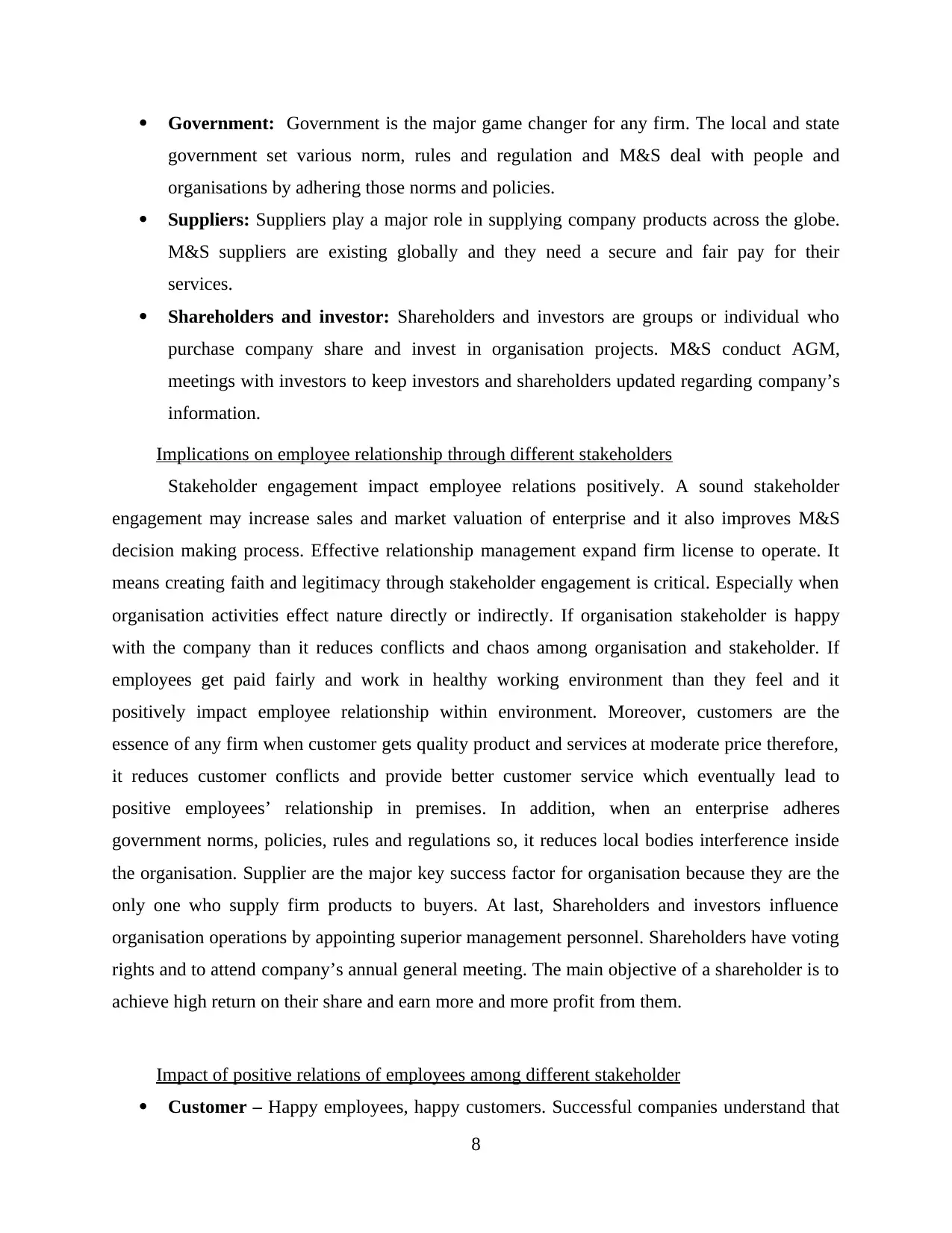
Government: Government is the major game changer for any firm. The local and state
government set various norm, rules and regulation and M&S deal with people and
organisations by adhering those norms and policies.
Suppliers: Suppliers play a major role in supplying company products across the globe.
M&S suppliers are existing globally and they need a secure and fair pay for their
services.
Shareholders and investor: Shareholders and investors are groups or individual who
purchase company share and invest in organisation projects. M&S conduct AGM,
meetings with investors to keep investors and shareholders updated regarding company’s
information.
Implications on employee relationship through different stakeholders
Stakeholder engagement impact employee relations positively. A sound stakeholder
engagement may increase sales and market valuation of enterprise and it also improves M&S
decision making process. Effective relationship management expand firm license to operate. It
means creating faith and legitimacy through stakeholder engagement is critical. Especially when
organisation activities effect nature directly or indirectly. If organisation stakeholder is happy
with the company than it reduces conflicts and chaos among organisation and stakeholder. If
employees get paid fairly and work in healthy working environment than they feel and it
positively impact employee relationship within environment. Moreover, customers are the
essence of any firm when customer gets quality product and services at moderate price therefore,
it reduces customer conflicts and provide better customer service which eventually lead to
positive employees’ relationship in premises. In addition, when an enterprise adheres
government norms, policies, rules and regulations so, it reduces local bodies interference inside
the organisation. Supplier are the major key success factor for organisation because they are the
only one who supply firm products to buyers. At last, Shareholders and investors influence
organisation operations by appointing superior management personnel. Shareholders have voting
rights and to attend company’s annual general meeting. The main objective of a shareholder is to
achieve high return on their share and earn more and more profit from them.
Impact of positive relations of employees among different stakeholder
Customer – Happy employees, happy customers. Successful companies understand that
8
government set various norm, rules and regulation and M&S deal with people and
organisations by adhering those norms and policies.
Suppliers: Suppliers play a major role in supplying company products across the globe.
M&S suppliers are existing globally and they need a secure and fair pay for their
services.
Shareholders and investor: Shareholders and investors are groups or individual who
purchase company share and invest in organisation projects. M&S conduct AGM,
meetings with investors to keep investors and shareholders updated regarding company’s
information.
Implications on employee relationship through different stakeholders
Stakeholder engagement impact employee relations positively. A sound stakeholder
engagement may increase sales and market valuation of enterprise and it also improves M&S
decision making process. Effective relationship management expand firm license to operate. It
means creating faith and legitimacy through stakeholder engagement is critical. Especially when
organisation activities effect nature directly or indirectly. If organisation stakeholder is happy
with the company than it reduces conflicts and chaos among organisation and stakeholder. If
employees get paid fairly and work in healthy working environment than they feel and it
positively impact employee relationship within environment. Moreover, customers are the
essence of any firm when customer gets quality product and services at moderate price therefore,
it reduces customer conflicts and provide better customer service which eventually lead to
positive employees’ relationship in premises. In addition, when an enterprise adheres
government norms, policies, rules and regulations so, it reduces local bodies interference inside
the organisation. Supplier are the major key success factor for organisation because they are the
only one who supply firm products to buyers. At last, Shareholders and investors influence
organisation operations by appointing superior management personnel. Shareholders have voting
rights and to attend company’s annual general meeting. The main objective of a shareholder is to
achieve high return on their share and earn more and more profit from them.
Impact of positive relations of employees among different stakeholder
Customer – Happy employees, happy customers. Successful companies understand that
8
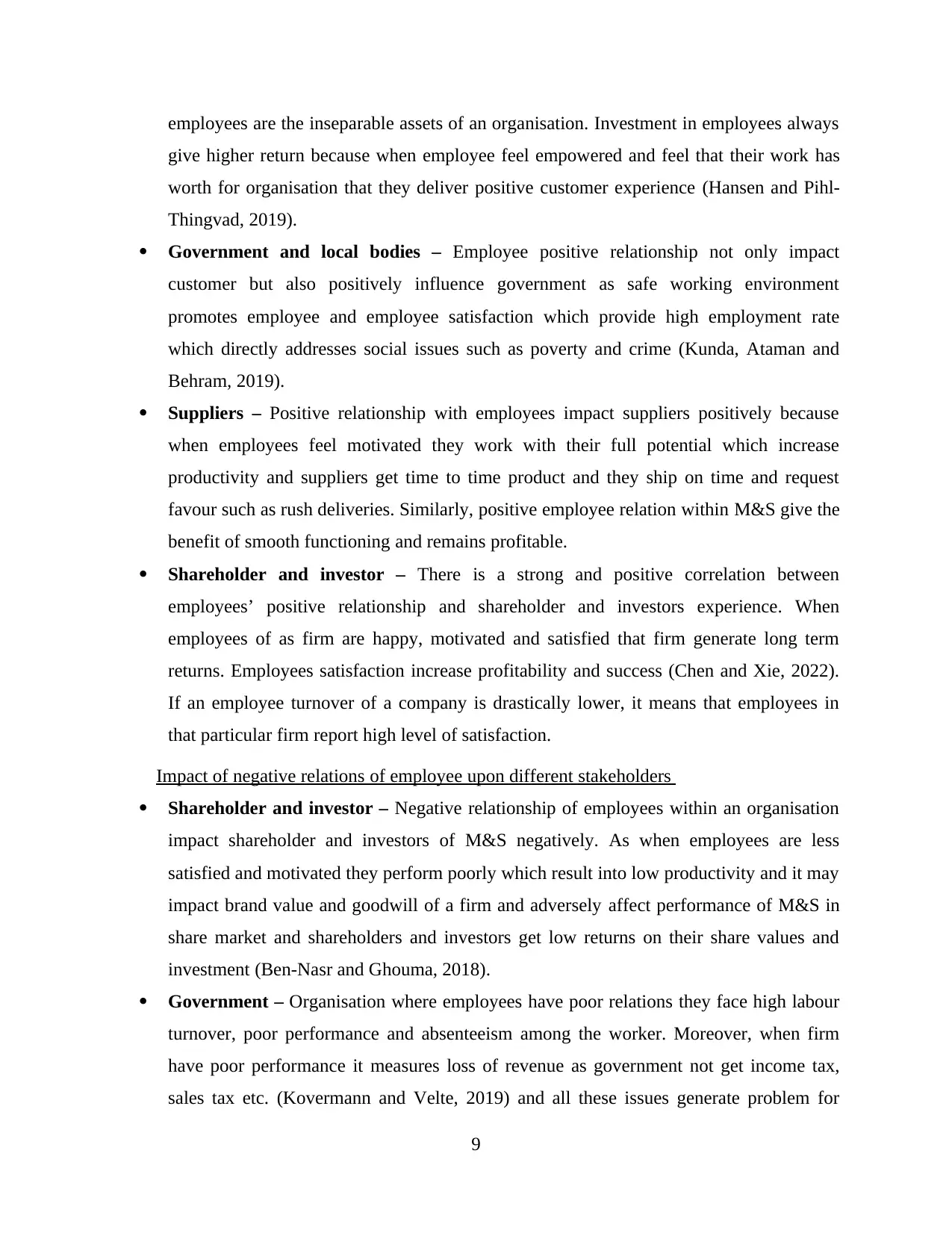
employees are the inseparable assets of an organisation. Investment in employees always
give higher return because when employee feel empowered and feel that their work has
worth for organisation that they deliver positive customer experience (Hansen and Pihl-
Thingvad, 2019).
Government and local bodies – Employee positive relationship not only impact
customer but also positively influence government as safe working environment
promotes employee and employee satisfaction which provide high employment rate
which directly addresses social issues such as poverty and crime (Kunda, Ataman and
Behram, 2019).
Suppliers – Positive relationship with employees impact suppliers positively because
when employees feel motivated they work with their full potential which increase
productivity and suppliers get time to time product and they ship on time and request
favour such as rush deliveries. Similarly, positive employee relation within M&S give the
benefit of smooth functioning and remains profitable.
Shareholder and investor – There is a strong and positive correlation between
employees’ positive relationship and shareholder and investors experience. When
employees of as firm are happy, motivated and satisfied that firm generate long term
returns. Employees satisfaction increase profitability and success (Chen and Xie, 2022).
If an employee turnover of a company is drastically lower, it means that employees in
that particular firm report high level of satisfaction.
Impact of negative relations of employee upon different stakeholders
Shareholder and investor – Negative relationship of employees within an organisation
impact shareholder and investors of M&S negatively. As when employees are less
satisfied and motivated they perform poorly which result into low productivity and it may
impact brand value and goodwill of a firm and adversely affect performance of M&S in
share market and shareholders and investors get low returns on their share values and
investment (Ben-Nasr and Ghouma, 2018).
Government – Organisation where employees have poor relations they face high labour
turnover, poor performance and absenteeism among the worker. Moreover, when firm
have poor performance it measures loss of revenue as government not get income tax,
sales tax etc. (Kovermann and Velte, 2019) and all these issues generate problem for
9
give higher return because when employee feel empowered and feel that their work has
worth for organisation that they deliver positive customer experience (Hansen and Pihl-
Thingvad, 2019).
Government and local bodies – Employee positive relationship not only impact
customer but also positively influence government as safe working environment
promotes employee and employee satisfaction which provide high employment rate
which directly addresses social issues such as poverty and crime (Kunda, Ataman and
Behram, 2019).
Suppliers – Positive relationship with employees impact suppliers positively because
when employees feel motivated they work with their full potential which increase
productivity and suppliers get time to time product and they ship on time and request
favour such as rush deliveries. Similarly, positive employee relation within M&S give the
benefit of smooth functioning and remains profitable.
Shareholder and investor – There is a strong and positive correlation between
employees’ positive relationship and shareholder and investors experience. When
employees of as firm are happy, motivated and satisfied that firm generate long term
returns. Employees satisfaction increase profitability and success (Chen and Xie, 2022).
If an employee turnover of a company is drastically lower, it means that employees in
that particular firm report high level of satisfaction.
Impact of negative relations of employee upon different stakeholders
Shareholder and investor – Negative relationship of employees within an organisation
impact shareholder and investors of M&S negatively. As when employees are less
satisfied and motivated they perform poorly which result into low productivity and it may
impact brand value and goodwill of a firm and adversely affect performance of M&S in
share market and shareholders and investors get low returns on their share values and
investment (Ben-Nasr and Ghouma, 2018).
Government – Organisation where employees have poor relations they face high labour
turnover, poor performance and absenteeism among the worker. Moreover, when firm
have poor performance it measures loss of revenue as government not get income tax,
sales tax etc. (Kovermann and Velte, 2019) and all these issues generate problem for
9
⊘ This is a preview!⊘
Do you want full access?
Subscribe today to unlock all pages.

Trusted by 1+ million students worldwide
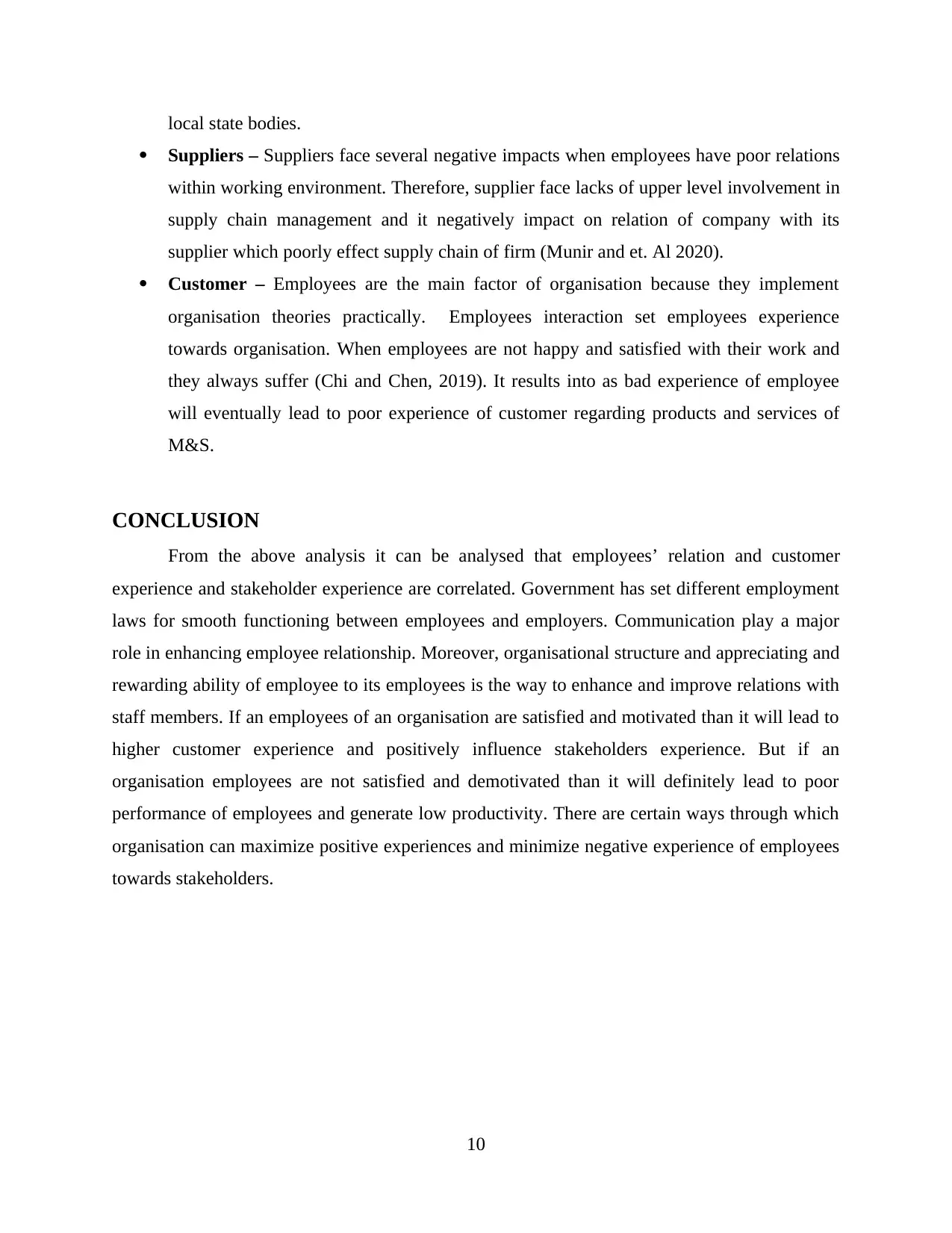
local state bodies.
Suppliers – Suppliers face several negative impacts when employees have poor relations
within working environment. Therefore, supplier face lacks of upper level involvement in
supply chain management and it negatively impact on relation of company with its
supplier which poorly effect supply chain of firm (Munir and et. Al 2020).
Customer – Employees are the main factor of organisation because they implement
organisation theories practically. Employees interaction set employees experience
towards organisation. When employees are not happy and satisfied with their work and
they always suffer (Chi and Chen, 2019). It results into as bad experience of employee
will eventually lead to poor experience of customer regarding products and services of
M&S.
CONCLUSION
From the above analysis it can be analysed that employees’ relation and customer
experience and stakeholder experience are correlated. Government has set different employment
laws for smooth functioning between employees and employers. Communication play a major
role in enhancing employee relationship. Moreover, organisational structure and appreciating and
rewarding ability of employee to its employees is the way to enhance and improve relations with
staff members. If an employees of an organisation are satisfied and motivated than it will lead to
higher customer experience and positively influence stakeholders experience. But if an
organisation employees are not satisfied and demotivated than it will definitely lead to poor
performance of employees and generate low productivity. There are certain ways through which
organisation can maximize positive experiences and minimize negative experience of employees
towards stakeholders.
10
Suppliers – Suppliers face several negative impacts when employees have poor relations
within working environment. Therefore, supplier face lacks of upper level involvement in
supply chain management and it negatively impact on relation of company with its
supplier which poorly effect supply chain of firm (Munir and et. Al 2020).
Customer – Employees are the main factor of organisation because they implement
organisation theories practically. Employees interaction set employees experience
towards organisation. When employees are not happy and satisfied with their work and
they always suffer (Chi and Chen, 2019). It results into as bad experience of employee
will eventually lead to poor experience of customer regarding products and services of
M&S.
CONCLUSION
From the above analysis it can be analysed that employees’ relation and customer
experience and stakeholder experience are correlated. Government has set different employment
laws for smooth functioning between employees and employers. Communication play a major
role in enhancing employee relationship. Moreover, organisational structure and appreciating and
rewarding ability of employee to its employees is the way to enhance and improve relations with
staff members. If an employees of an organisation are satisfied and motivated than it will lead to
higher customer experience and positively influence stakeholders experience. But if an
organisation employees are not satisfied and demotivated than it will definitely lead to poor
performance of employees and generate low productivity. There are certain ways through which
organisation can maximize positive experiences and minimize negative experience of employees
towards stakeholders.
10
Paraphrase This Document
Need a fresh take? Get an instant paraphrase of this document with our AI Paraphraser
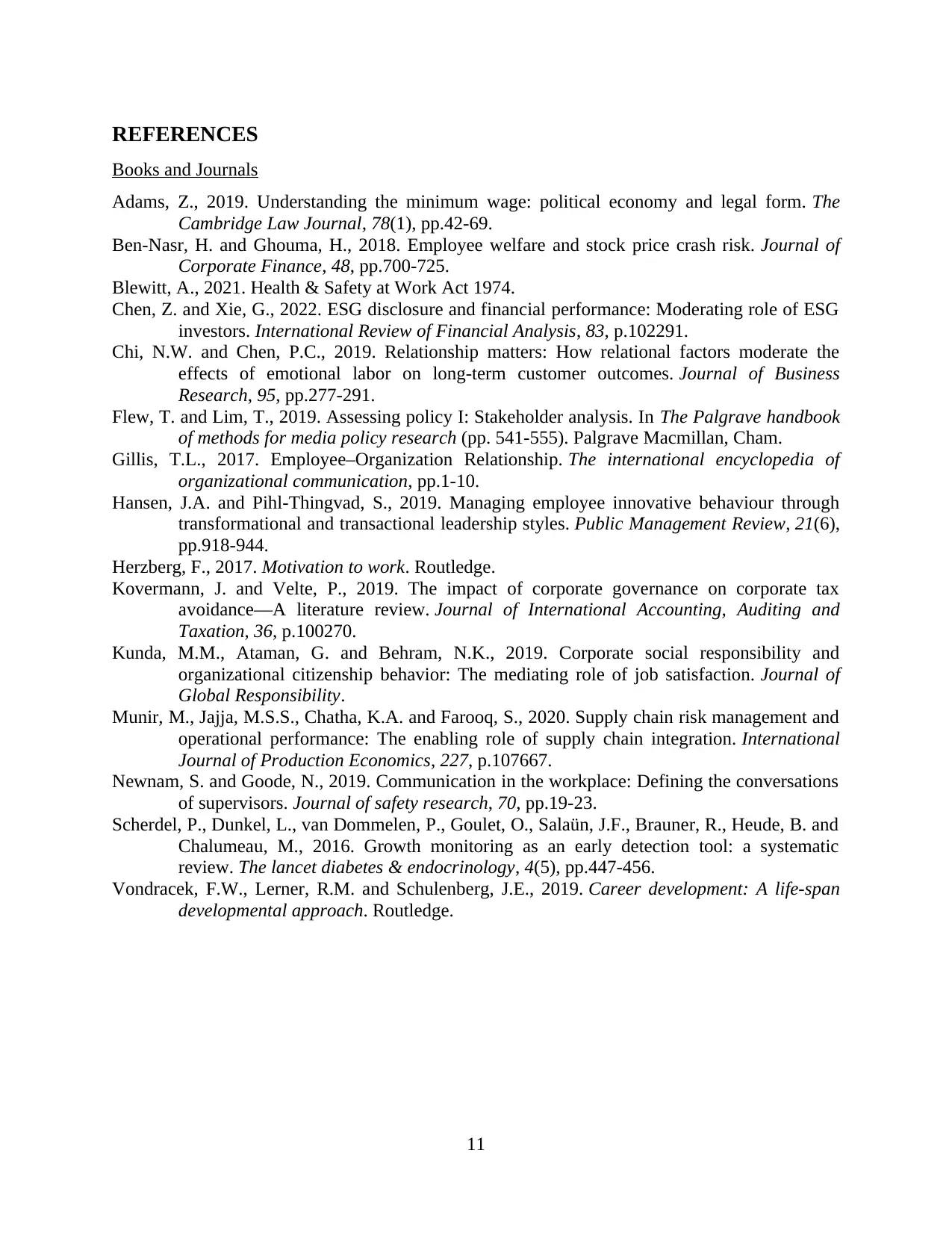
REFERENCES
Books and Journals
Adams, Z., 2019. Understanding the minimum wage: political economy and legal form. The
Cambridge Law Journal, 78(1), pp.42-69.
Ben-Nasr, H. and Ghouma, H., 2018. Employee welfare and stock price crash risk. Journal of
Corporate Finance, 48, pp.700-725.
Blewitt, A., 2021. Health & Safety at Work Act 1974.
Chen, Z. and Xie, G., 2022. ESG disclosure and financial performance: Moderating role of ESG
investors. International Review of Financial Analysis, 83, p.102291.
Chi, N.W. and Chen, P.C., 2019. Relationship matters: How relational factors moderate the
effects of emotional labor on long-term customer outcomes. Journal of Business
Research, 95, pp.277-291.
Flew, T. and Lim, T., 2019. Assessing policy I: Stakeholder analysis. In The Palgrave handbook
of methods for media policy research (pp. 541-555). Palgrave Macmillan, Cham.
Gillis, T.L., 2017. Employee–Organization Relationship. The international encyclopedia of
organizational communication, pp.1-10.
Hansen, J.A. and Pihl-Thingvad, S., 2019. Managing employee innovative behaviour through
transformational and transactional leadership styles. Public Management Review, 21(6),
pp.918-944.
Herzberg, F., 2017. Motivation to work. Routledge.
Kovermann, J. and Velte, P., 2019. The impact of corporate governance on corporate tax
avoidance—A literature review. Journal of International Accounting, Auditing and
Taxation, 36, p.100270.
Kunda, M.M., Ataman, G. and Behram, N.K., 2019. Corporate social responsibility and
organizational citizenship behavior: The mediating role of job satisfaction. Journal of
Global Responsibility.
Munir, M., Jajja, M.S.S., Chatha, K.A. and Farooq, S., 2020. Supply chain risk management and
operational performance: The enabling role of supply chain integration. International
Journal of Production Economics, 227, p.107667.
Newnam, S. and Goode, N., 2019. Communication in the workplace: Defining the conversations
of supervisors. Journal of safety research, 70, pp.19-23.
Scherdel, P., Dunkel, L., van Dommelen, P., Goulet, O., Salaün, J.F., Brauner, R., Heude, B. and
Chalumeau, M., 2016. Growth monitoring as an early detection tool: a systematic
review. The lancet diabetes & endocrinology, 4(5), pp.447-456.
Vondracek, F.W., Lerner, R.M. and Schulenberg, J.E., 2019. Career development: A life-span
developmental approach. Routledge.
11
Books and Journals
Adams, Z., 2019. Understanding the minimum wage: political economy and legal form. The
Cambridge Law Journal, 78(1), pp.42-69.
Ben-Nasr, H. and Ghouma, H., 2018. Employee welfare and stock price crash risk. Journal of
Corporate Finance, 48, pp.700-725.
Blewitt, A., 2021. Health & Safety at Work Act 1974.
Chen, Z. and Xie, G., 2022. ESG disclosure and financial performance: Moderating role of ESG
investors. International Review of Financial Analysis, 83, p.102291.
Chi, N.W. and Chen, P.C., 2019. Relationship matters: How relational factors moderate the
effects of emotional labor on long-term customer outcomes. Journal of Business
Research, 95, pp.277-291.
Flew, T. and Lim, T., 2019. Assessing policy I: Stakeholder analysis. In The Palgrave handbook
of methods for media policy research (pp. 541-555). Palgrave Macmillan, Cham.
Gillis, T.L., 2017. Employee–Organization Relationship. The international encyclopedia of
organizational communication, pp.1-10.
Hansen, J.A. and Pihl-Thingvad, S., 2019. Managing employee innovative behaviour through
transformational and transactional leadership styles. Public Management Review, 21(6),
pp.918-944.
Herzberg, F., 2017. Motivation to work. Routledge.
Kovermann, J. and Velte, P., 2019. The impact of corporate governance on corporate tax
avoidance—A literature review. Journal of International Accounting, Auditing and
Taxation, 36, p.100270.
Kunda, M.M., Ataman, G. and Behram, N.K., 2019. Corporate social responsibility and
organizational citizenship behavior: The mediating role of job satisfaction. Journal of
Global Responsibility.
Munir, M., Jajja, M.S.S., Chatha, K.A. and Farooq, S., 2020. Supply chain risk management and
operational performance: The enabling role of supply chain integration. International
Journal of Production Economics, 227, p.107667.
Newnam, S. and Goode, N., 2019. Communication in the workplace: Defining the conversations
of supervisors. Journal of safety research, 70, pp.19-23.
Scherdel, P., Dunkel, L., van Dommelen, P., Goulet, O., Salaün, J.F., Brauner, R., Heude, B. and
Chalumeau, M., 2016. Growth monitoring as an early detection tool: a systematic
review. The lancet diabetes & endocrinology, 4(5), pp.447-456.
Vondracek, F.W., Lerner, R.M. and Schulenberg, J.E., 2019. Career development: A life-span
developmental approach. Routledge.
11
1 out of 11
Related Documents
Your All-in-One AI-Powered Toolkit for Academic Success.
+13062052269
info@desklib.com
Available 24*7 on WhatsApp / Email
![[object Object]](/_next/static/media/star-bottom.7253800d.svg)
Unlock your academic potential
Copyright © 2020–2025 A2Z Services. All Rights Reserved. Developed and managed by ZUCOL.





